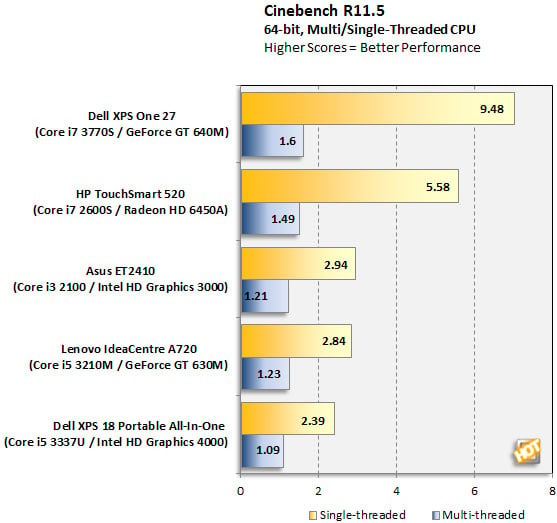Dell XPS 18 Portable All-In-One Desktop Review
SiSoft Sandra & CineBench
|
 |
 |
The Dell XPS 18 Portable All-In-One is equipped with an Intel Core i5 3337U processor, a mid-range Ivy Bridge part with two cores clocked at 1.8GHz (2.7GHz via Turbo), Hyper Threading support, and 3MB of Smart Cache. SiSoft SANDRA's processor scores were a little lower than what we've seen from other AIO systems, though we're also running a newer version, which SiSoft says shouldn't be compared to previous builds.
The memory score is more in line with what we were expecting, considering the 8GB of relatively fast DDR3-1600 memory Dell shoved inside. As for storage, the 93.47MB/s isn't earth shattering by any means, though it doesn't fully take into consideration the 32GB mSATA SSD, which has a noticeable impact on day-to-day computing chores. The system definitely boots and feels faster than rigs that rely solely on a mechanical hard drive.
|
Maxon's Cinebench R11.5 benchmark is based on Maxon's Cinema 4D software used for 3D content creation chores and tests both the CPU and GPU in separate benchmark runs. On the CPU side, Cinebench renders a photorealistic 3D scene by tapping into up to 64 processing threads (CPU) to process more than 300,000 total polygons, while the GPU benchmark measures graphics performance by manipulating nearly 1 million polygons and huge amounts of textures.

The XPS 18 sat at the bottom of the pack in Cinebench's CPU tests, and though it trailed by a small margin, the real takeaway here is that for all of the system's flexibility, one thing you're not going to be doing is heavy-duty CAD work or 3D design. It doesn't have the horsepower required for such tasks, though it's not totally devoid of some capability in this regard either.

In the OpenGL portion of the test, the XPS 18 lifted itself up from the bottom of the back and settled comfortably in the middle, besting the HP TouchSmart and Asus ET2410. It only trailed two systems equipped with more modern discrete GPUs. Not a bad showing for Intel's HD Graphics 4000.








